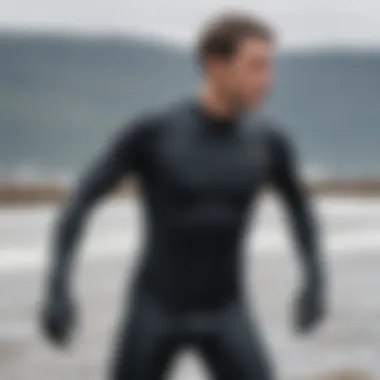Comparing Wet Suits and Dry Suits for Kiteboarding


Intro
Kiteboarding can be a thrilling adventure, but the comfort and safety of the ride depend heavily on the gear you choose, particularly your thermal protection. Among the most critical pieces of equipment are wetsuits and drysuits. While both serve the purpose of insulating and protecting you from the elements, they function quite differently in various environments. Understanding these differences is key to making an informed decision that not only enhances your performance but also ensures your safety.
This article takes a comprehensive look into the design features, material choices, and insulation properties of wetsuits and drysuits, specifically tailored for kiteboarding. There's plenty of ground to cover here, but each point is vital for enhancing your kiteboarding experience and making educated gear selections.
Gear Selection
When it comes to kiteboarding, the right gear can make a world of difference. This section delves into the foundational elements that influence gear choices, focusing on suits and other essential equipment.
Types of Kites
Choosing the right kite is equally important as selecting the appropriate suit. There are various types of kites, each offering unique features that cater to different riding styles and conditions. For instance, the C-kite is designed for explosive power and performance, favoured mostly by freestyle enthusiasts, while flat kites can be more stable for beginners. Additionally, wave kites are ideal for those windy days at sea.
A kite that matches your skill level and intended activities can significantly impact your overall enjoyment.
Keep in mind, it's not just about the suit; if you're suited up in a drysuit but battling with a kite that isn't up to snuff, you might as well be sailing in choppy waters with no sail!
Choosing the Right Board
Selecting the right board is another critical step. The board’s size, shape, and flex play a crucial role in how you’ll perform on water. For instance, a wider board provides better stability, making it more suitable for beginners. On the other hand, a narrower and longer board can enhance speed and maneuverability, appealing more to seasoned riders.
You’ll want to consider your personal preferences along with the local conditions you’ll most often face—whether it’s choppy waters or smooth waves. Matching your board and suit together must be done with care, as complementary gear can hugely influence your comfort and performance.
"The right gear doesn’t just protect you, it sets you free to fully enjoy the ride!"
Remember that both wetsuits and drysuits come in varying thicknesses designed to provide specific levels of insulation based on temperature. A good suit will not just guard against the chill; it will blend seamlessly with your gear to create an efficient and responsive kiteboarding setup for your adventures.
By thoroughly understanding what you need and how each piece of gear works together, you can embark on your kiteboarding ventures with assurance and preparation.
Preface to Thermal Protection Gear
When kiteboarding, thermal protection gear is no mere accessory; it’s a necessity. As enthusiasts venture into the chilly embrace of ocean waves or river currents, the right gear can make the difference between an exhilarating day on the water and an uncomfortable, potentially dangerous experience. This section discusses the integral role that thermal suits—wet suits and dry suits—play in ensuring safety and comfort during kiteboarding sessions.
The Importance of Thermal Regulation
Thermal regulation while kiteboarding isn’t just about avoiding a chill; it’s about enhancing performance and safety. Water temperature can plunge quite significantly, especially during early mornings or late afternoons. A drop in body temperature leads to hypothermia, a condition where the body loses heat faster than it can produce it. Therefore, maintaining an adequate thermal balance while braving the elements shouldn’t be an afterthought. Choosing the right thermal protection gear can host various advantages:
- Safety First: A wet suit or dry suit keeps core body temperature stable, reducing the toll that cold water can take.
- Extended Sessions: With proper thermal gear, kiteboarders can spend more time engaging with their sport, fully in their element without the nagging bite of the cold.
- Enhanced Comfort: No more freezing while waiting for the wind to pick up! Thermal protection gear allows better focus and enjoyment during kiteboarding activities.
Overview of Wet Suits and Dry Suits
Wet suits and dry suits serve similar purposes but operate on different mechanics and designs. Understanding these differences can significantly impact your kiteboarding experience.
Wet Suits are primarily constructed from neoprene, a material that allows a thin layer of water to enter and warm up against your body. This layer acts like a barrier that traps heat, keeping you warm while still allowing movement.
Dry Suits, on the other hand, are designed to keep an individual completely dry. They typically have sealed seams and closures that prevent water from seeping in, thus isolating the wearer from cold water altogether. Dry suits can be bulkier, as they often include insulation layers for added warmth, making it essential to select based on the specific conditions faced in your kiteboarding adventures.


In understanding wet suits and dry suits, kiteboarders gain the insight necessary to choose optimal gear tailored to the unpredictability of nature's elements.
"The proper gear can mean the world to a kiteboarder's experience; it’s integral to embrace the elements rather than endure them."
In summary, the choice of thermal protection gear should not be taken lightly. The difference between a wet suit and a dry suit lies not only in their physical structure, but also in their performance under diverse environmental conditions. With the right information, kiteboarders can confidently make decisions that enhance both safety and enjoyment on the water.
Wet Suits: Design and Functionality
Wet suits are the backbone of thermal protection for kiteboarders, especially when tackling unpredictable waters. Understanding their design and functionality can make all the difference in enhancing performance and ensuring comfort while riding the waves. This segment delves into the specific elements that define wet suits, focusing on the materials, construction methods, and overall user benefits.
Materials Used in Wet Suits
Wet suits are primarily crafted from neoprene, a synthetic rubber that possesses excellent insulation properties. This material is not just durable; it’s also flexible, enabling ease of movement for kiteboarders as they maneuver through the water. The thickness of neoprene can vary, typically ranging from 2mm to 7mm, depending on the specific needs of the user and water temperature.
- Smooth Skin Neoprene: This type is smooth on the outside and can reduce wind chill while boosting insulation. However, it can be less durable than its counterparts.
- Limestone Neoprene: More environmentally friendly, limestone-backed neoprene provides adequate insulation and tends to be a more sustainable choice in wet suit production.
- Glideskin: Often used in the collar, wrist, and ankle areas for better water resistance and a snug fit.
These materials come together to not only create a protective barrier against cold waters but also optimize buoyancy and flexibility crucial for kiteboarding activities.
How Wet Suits Work
The functionality of a wet suit hinges on its ability to maintain warmth through a simple yet effective principle: the suit traps a thin layer of water between the wearer’s skin and the suit itself. As a kiteboarder moves around, the body generates heat, warming this layer of water and helping to keep the body comfortably insulated. This mechanism works best in cooler conditions where the water temperature is lower than the body’s natural temperature.
A key aspect in how wet suits function lies in their ability to fit snugly. A tailored fit prevents excess water from rushing in, which could wash away the warmed water layer. This is why many manufacturers prioritize a precise design during production. Moreover, it’s important to account for features such as zippers, seals, and stitching, which can affect how well a suit performs in keeping water at bay.
Benefits of Wearing a Wet Suit
The advantages of wearing a wet suit while kiteboarding are numerous, making them an indispensable part of a rider's gear:
- Thermal Insulation: Wet suits help maintain core temperature, preventing hypothermia in colder water conditions.
- Flexibility and Protection: Most modern designs emphasize flexibility without sacrificing protection, allowing for full range of motion during tricks or falls.
- Buoyancy: The use of neoprene provides natural buoyancy, enhancing flotation in tricky conditions, which is vital when the kiteboarder might encounter unexpected challenges.
- Abrasion Resistance: Wet suits can protect against minor scrapes with rough surfaces like rocks or reefs, offering an extra layer of safety.
Using a wet suit means you're better equipped to handle varying temperature fluctuations, sudden dips in water temperature, and impacts from falls. As the saying goes, "Better safe than sorry!" In the passionate world of kiteboarding, this philosophy rings true.
"Choosing the right wet suit can turn a cold, uncomfortable day on the water into a thrilling adventure. Always choose wisely."
Dry Suits: Structure and Usability
The topic of dry suits is integral to understanding the full spectrum of thermal protection provided to kiteboarders. While wet suits are often favored for their snug fit and flexibility in warm waters, dry suits cater to those tackling colder, harsher environments. Their intricate structure and usability make them a pivotal choice for those wanting to extend their time on the water during chilly temperatures.
Key Features of Dry Suits
When considering a dry suit, several key features stand out that dictate its performance and effectiveness:
- Waterproof Materials: Dry suits are primarily designed using high-quality waterproof materials such as GORE-TEX or other breathable membranes. This not only prevents water from getting in but allows perspiration to escape.
- Sealed Seams: The seams of a dry suit are meticulously sealed. Usually employing tape or welding techniques, these sealed seams ensure no water trickles in, regardless of heavy splashes.
- Cuff Seals: Cuffs often come with latex or neoprene seals at the neck and wrists, snugly fitting around the body to keep water out and maintain insulation.
- Zipper Types: Some dry suits feature waterproof zippers. The placement can vary; while back zippers are traditional, front zippers provide easier access and versatility in wearing.
These features compile to create a robust shield against the elements, allowing for a focused experience without the distraction of the cold.
Thermal Insulation Mechanisms


The insulation within dry suits is crucial. Unlike wet suits that rely on water for thermal insulation, dry suits employ trapped air to provide warmth. The inherent design leads to:
- Layering Capability: Many dry suit users prefer layering thermal undergarments underneath. This provides flexibility, allowing the kiteboarder to adjust insulation according to the day’s temperature.
- Trapped Air: Since dry suits block water altogether, the air captured within acts as an insulating layer. This method retains body heat effectively, making users feel cozy even in brisk winds.
- Moisture Management: Advanced moisture-wicking materials contribute to comfort, helping manage sweat and keeping the skin dry. Avoiding clammy, baggy feeling is important for agility during kiteboarding activities.
A well-layered thermal setup ensures prolonged comfort on the water even amidst unpredictable weather changes.
Advantages of Using a Dry Suit
Choosing a dry suit brings forward numerous advantages worth considering for avid kiteboarders:
- Extended Use in Cold Weather: The primary selling point lies in its capability to perform well in colder waters, making it viable for early spring or late autumn sessions.
- Versatility: Dry suits are not limited to kiteboarding. They serve well in various water activities such as kayaking, paddleboarding, and even diving, thereby making them versatile investments.
- Freedom of Movement: Although they may seem bulky, modern designs prioritize mobility. Many dry suits include articulated limbs that allow for dynamic movements essential for sport.
- Increased Safety: With dry suits keeping water at bay, there's less risk of hypothermia, allowing kiteboarders to focus on their performance rather than combating the cold.
In summary, understanding the structure and usability of dry suits allows kiteboarders to evaluate their gear options effectively. By selecting a dry suit, one is opting for comprehensive thermal protection that supports performance and enhances safety in variable environmental conditions.
Comparative Analysis: Wet Suits vs. Dry Suits
The choice between wet suits and dry suits can vastly influence a kiteboarder’s experience on the water. Understanding the nuances between these two types of thermal protection gear is integral. Each suit serves distinct purposes and performs differently under various conditions. By drawing a comparative analysis, kiteboarders can make informed decisions that enhance their overall enjoyment and safety.
Suit Performance in Different Conditions
Weather plays a huge role in kiteboarding, and choosing the right suit based on conditions can be the difference between a thrilling ride and an uncomfortable day. Wet suits excel in warmer water where the ambient temperature is moderate. They work by trapping a thin layer of water against the body, which warms up due to body heat. This self-heating can keep you comfortable in chilly waters, but once the temperatures dip significantly below, wet suits begin to falter.
On the other hand, dry suits are designed for colder environments. They are insulated and keep all water out, allowing for the use of under layers to combat extreme temperatures. Think of dry suits as little insulated fortresses keeping you cozy. If the water temperature is surprisingly frigid, you're going to want to opt for a dry suit. However, it’s important to note that while dry suits keep you warm, they can also result in more bulk and may limit mobility when compared to wet suits.
"The right suit can change a kiteboarder’s day from freezing misery to a thrilling adventure."
Comfort Levels in Various Environments
Comfort while kiteboarding doesn’t solely stem from warmth. It also encompasses mobility and flexibility. Wet suits, being more figure-hugging, often provide a second-skin feel. This enhances dexterity and responsiveness, making it easier to maneuver when zipping across the waves. However, if there’s a bit of wind chill combined with water spray, a wet suit may leave one feeling a tad too cold for comfort. Moreover, during prolonged sessions in cooler conditions, the limited thermal protection of a wet suit could take a toll on your enjoyment.
Conversely, dry suits, with their layered setup, allow for greater adjustments in terms of warmth. Many kiteboarders appreciate the ability to wear varied layers depending on weather changes. But, keep in mind that they may feel bulkier. The added weight of a dry suit can lead to a steeper learning curve, especially for newcomers who may feel restricted when learning tricks or navigation. The trade-off often comes down to personal comfort preferences and intended use.
User Scenarios for Each Suit Type
When assessing scenarios, let’s consider the types of kiteboarding experiences one may encounter. For the casual kiteboarder hitting the beach during a late summer session, a wet suit is typically sufficient. It’s light, allows for a full range of motion, and keeps the rider warm without making them feel like they’re wearing a cumbersome outfit.
However, if someone is planning a winter trip to a renowned kiteboarding destination such as Cape Cod or the chilly waters near Vancouver, the dry suit becomes indispensable. It can withstand not only the cold waters but also potential wind chill that would leave a wet suit lacking.
Here’s a quick overview of user scenarios:
- Casual Summer Sessions: Ideal for light wet suits.
- Spring and Fall Adventures: Might require thicker wet suits for chillier temps.
- Winter Kiteboarding: Opt for dry suits for maximum warmth and dryness.
- Extreme or Remote Locations: Dry suits offer safety against unpredictable temperatures.
Knowing the conditions you’ll be in, and how the suits can perform will lead you to a better understanding of which suit is best for you. As in all things, the right gear correlates closely to the kind of experience you seek.
Choosing the Right Suit for Kiteboarding
Selecting the appropriate suit for kiteboarding is a crucial decision that can significantly impact your overall experience on the water. This section dives into the specific elements to consider when choosing between a wet suit and a dry suit. It sheds light on the benefits of each option, takes personal preferences into account, and highlights the importance of investing in quality gear. Let’s break down these considerations to ensure you make an informed choice.


Assessing Water Temperature and Weather Conditions
Water temperature and weather conditions play a pivotal role in determining whether a wet suit or dry suit is most suitable for your kiteboarding adventures. Generally, wet suits are ideal for warmer waters; they allow a layer of water to enter and get trapped, which then warms up by body heat. On the other hand, dry suits shine in chilly environments, keeping you warm and dry even when the weather is less than favorable.
For example, if you find yourself kiteboarding in cold, brisk waters, a dry suit would be the way to go. It keeps you insulated and dry, making it easier to handle those chilled gusts of wind without shivering in your boots. Warm-weather enthusiasts, however, often prefer wet suits as they provide flexibility and comfort in sunny conditions.
Maintenance and Care for Wet Suits and Dry Suits
Maintaining your thermal protection gear is just as vital as selecting the right suit for kiteboarding. Proper care prolongs the lifespan of your gear and enhances its performance. For kiteboarders, users of either wet suits or dry suits face specific challenges when it comes to maintenance. Failing to follow proper care protocols can lead to reduced insulation, discomfort, and even costly replacements. Let’s dive into some critical elements of maintenance and care for both suits.
Proper Cleaning Techniques
Keeping your suit clean is paramount. Saltwater, sand, and chlorinated pools can wreak havoc on the fabric over time. Here’s how to ensure your wet or dry suit stays in tip-top shape:
- Rinse Immediately: After every session, rinse your suit thoroughly with fresh water. This removes salt and sand particles that could damage the fabric.
- Use Mild Detergents: If a deep clean is warranted, use mild, suit-specific detergents. Avoid harsh chemicals that can break down the material.
- Gentle Wash: If you use a washing machine, opt for the gentle cycle with cold water. Hand washing is also a great way to avoid excessive wear and tear.
Letting it air dry after washing is the best approach. Don't wring it out, as that puts stress on the seams, leading to potential leaks later.
Storage Recommendations
Proper storage practices can save you from unnecessary wear, enhancing your suit's lifespan.
- Avoid Direct Sunlight: Store your suit in a cool, dry place away from direct sunlight. UV rays can degrade the materials.
- Hang it Right: Use a thick hanger to support the suit's weight. Thin hangers can create unnecessary creases or damage the shoulders.
- Roll, Don’t Fold: If you’re packing it away for a while, roll it up instead of folding it. This method prevents permanent creases from forming.
- Keep Away from Heat Sources: Maintaining a safe distance from heat sources like radiators or heaters is crucial. Heat can warp the suit and affect its insulation properties.
Repairing Common Issues
Even with the best care, wear and tear can happen. Recognizing and fixing common issues early can prevent worse damage later on.
- Check for Tears and Leaks: Regularly inspect your suit for small rips or punctures. When you spot one, don't ignore it. Repair kits, often available in sports stores, can be your best friends here, allowing for a DIY fix.
- Seal the Seams: Sometimes the seams can start to leak. Use seam sealant designed explicitly for suits to ensure you remain dry. This can be particularly crucial for dry suits, where even the tiniest gap can usher in unwanted water.
- Replace Zippers: If you notice zippers malfunctioning, it’s time to act. Leaks can occur if they don’t fully close. Zippers can be tricky to replace on your own, and consulting a professional is often best.
In summary, consistently investing time in the maintenance and care of wet suits and dry suits ensures your gear remains functional and reliable. Keeping the suits clean, following proper storage techniques, and addressing issues promptly can afford kiteboarders a better experience on the water, ultimately enhancing the enjoyment of the sport.
The End: Making an Informed Choice
When it comes to participating in kiteboarding, selecting the appropriate thermal protection is of utmost importance. This section synthesizes the essential elements regarding wet suits and dry suits, aimed at equipping kiteboarders with the knowledge necessary for informed decision-making. The process of choosing between these two types of suits involves several considerations, such as environmental conditions, personal comfort, and performance expectations.
Understanding the nuances of each suit type ensures that you are adequately prepared for your kiteboarding adventure. A well-chosen wetsuit can keep you warm and flexible, whereas a dry suit offers a higher level of insulation, particularly in colder waters. The choice can mean the difference between a thrilling day on the water and an uncomfortable session.
Recap of Key Insights
Throughout this article, we've delved into various aspects of wet suits and dry suits, uncovering valuable insights:
- Material Composition: Wet suits are generally made from neoprene, designed to create a thermal layer through trapped water, while dry suits utilize waterproof materials that prevent water ingress entirely.
- Thermal Regulating Properties: Wet suits allow for some water to enter, which then warms up due to body heat. In contrast, dry suits are equipped with insulation layers and rely on the presence of air for thermal retention.
- Unique Advantages: Each suit type serves its purpose; wet suits excel in warmer temperatures, providing flexibility, while dry suits shine in frigid waters where warmth is paramount.
Understanding these differences helps kiteboarders make choices that enhance their experience and boost safety on the water.
Final Thoughts on Gear Selection
In the end, selecting the right suit for kiteboarding is a bit like selecting the right tool for a job; it’s best to choose wisely according to your specific needs. Quality gear can significantly impact your performance, safety, and overall enjoyment. Don't overlook critical factors such as:
- Water Temperature: Recognize the conditions you will be facing. A suit that works well in milder waters may not suffice in colder environments.
- Personal Comfort: Fit, flexibility, and the material's feel against your skin can greatly affect how enjoyable your session is.
- Investment Value: Good gear is not cheap, but it's worth the price for both safety and performance benefits. Consider purchasing well-reviewed brands known for durability and comfort.
Ultimately, whether you’re cruising along the coast or tackling more challenging conditions, being well-equipped can lead to a safer, more enjoyable kiteboarding experience. Do your research, reflect on your paddling habits, and make the choice that aligns best with your kiteboarding aspirations.















